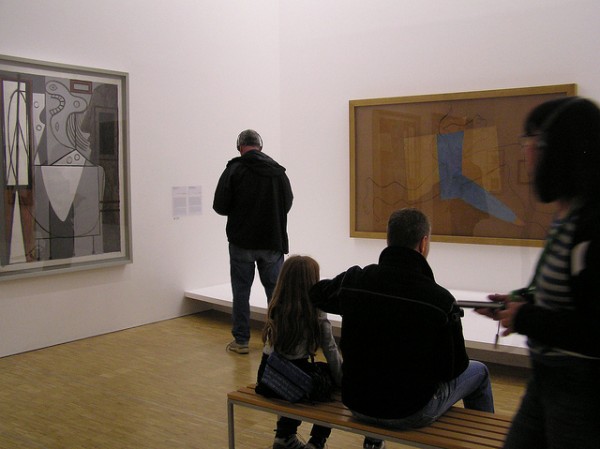
Museums have a lot of people to answer to: artists and critics, curators and funders, and of course the visitors who stroll through their doors. Successful museums somehow satisfy–and even thrill–these many different constituencies, even as they adjust to changing technology and demographics in their communities. How do these museums do it? In advance of the Zócalo event “How Can L.A.’s Art Museums Thrive?” we asked museum directors and scholars to reveal the secret behind a successful museum.
Ask its visitors
 A successful museum is an institution that matters to its community. It has nothing to do with the collection, who designed the building, or how big the endowment is. The secret to a successful museum is in how it relates and responds to people.
A successful museum is an institution that matters to its community. It has nothing to do with the collection, who designed the building, or how big the endowment is. The secret to a successful museum is in how it relates and responds to people.
A successful museum is not only relevant but useful to the community in which it is situated. It is a place that people use for social activities, learning, aspirational musings, and deeper connection. It is not a place that prescribes set relationships and activities. It collaborates with community members to define useful purposes based on their assets, abilities, and interests. People on the street should be able to tell you not just what the museum has but what it does.
What does this look like in practice? The Pittsburgh Children’s Museum is committed to making the Northside the best place in the city to raise children, so it supports projects beyond its walls to encourage healthy families. Chicago’s Jane Addams Hull-House Museum sees its history of social justice as a mandate to support activists with a gathering place for dialogue and learning. Seattle’s Wing Luke Asian Museum takes a citizen journalism approach, co-creating exhibitions with community members on important issues in their lives. At my little museum in Santa Cruz, we partner with hundreds of local artists and community groups to co-produce events that bridge social divisions and celebrate local culture.
A successful museum doesn’t treat visitors as consumers, pupils, or people in need. Instead, staff members look at visitors as prospective collaborators and provide structured opportunities for visitors to add their unique perspectives, creative abilities, or knowledge to the institution. The successful museum is actively engaged with its community in co-creation of value. What is a successful museum? Ask its visitors.
Nina Simon is the executive director of the Santa Cruz Museum of Art & History and the author of The Participatory Museum and the Museum 2.0 blog.
————————————-
Keeping visitors happy (and giving them a place to sit)
 Museums and their funders use a number of categories–annual visitation, fiscal health, size, influence–to judge museums against each other.
Museums and their funders use a number of categories–annual visitation, fiscal health, size, influence–to judge museums against each other.
But from the visitor’s perspective, a successful museum is one that satisfies intellectual, emotional, social, and physical needs. The museum knows who visits, and develops exhibitions and programs that recognize that the general public is not one indistinguishable lump but is comprised of individuals with varied interests, abilities, and reasons for visiting. Satisfying all these visitors is tricky, but the successful museum achieves this by sharing its plan and vision with everyone, from board members and employees to volunteers and visitors.
Successful museums are beloved by their constituencies because they carefully balance continuity and change. Visitors love revisiting objects that have become old friends but also enjoy the stimulation of the new and unfamiliar. Museums must take risks in order to stay unique, which means pushing themselves and visitors to engage with topics that might be contentious or difficult to talk about. But beloved museums can count on their constituents’ trust, making risk less risky.
Many children’s, history, and science museums–and some art museums–know that success lies less in the acquisition of the “best,” and more in what a museum does to help visitors find significance in what they behold or experience. It is fashionable these days to “allow” visitors to make their own meanings, but museums can still help these same visitors grapple with the ideas of others. Given the plethora of communication tools available, coupled with the ever-growing knowledge of visitors’ behavior and learning, there is no excuse for shirking interpretation.
But most importantly, the successful museum has comfortable places to sit.
Cynthia Robinson is Director of Museum Studies at Tufts University, where she teaches museum education after a 25-year career in museums. She is also co-editor-in-chief of the Journal of Museum Education.
————————————-
Going outside museum walls to plan for the future
 A successful museum continually keeps an eye on its external environment–and not only takes steps in the present to be relevant and meaningful, but actively visualizes and plans for its future.
A successful museum continually keeps an eye on its external environment–and not only takes steps in the present to be relevant and meaningful, but actively visualizes and plans for its future.
Nowhere is this more important than California, the most diverse state in the nation. The California Association of Museums and other associations believe that museums can play a role in preparing for, and responding to, social, technological, economic, environmental, and political challenges in their communities. The American Association of Museums report Museums & Society 2034: Trends and Potential Futures notes that “a museum’s viability is tied to its community’s health”-which means that museums can and should take a more proactive role in helping “society deal with seismic shifts in demographics, the economy, technology and culture.”
A continual focus on what is occurring outside the museum’s walls is essential to adjusting to California’s future reality, which is anticipated to be a dramatically more diverse and interconnected community. Successful museums are committed to being 21st century organizations by responding to the evolving external environment and needs of the communities they serve–and being relevant and civic-minded centers of community.
Celeste DeWald is the executive director of the California Association of Museums and administrator of a statewide project titled Leaders of the Future: Museum Professionals Developing Strategic Foresight.
————————————-
Art, audiences, and support
 Art museums are educational institutions that bring great works of art to large and diverse audiences in order to transform people’s lives for the better. The secret to our success is threefold: art, audiences, and support.
Art museums are educational institutions that bring great works of art to large and diverse audiences in order to transform people’s lives for the better. The secret to our success is threefold: art, audiences, and support.
Successful museums build collections, present important exhibitions, and help visitors make personal connections to art.
They know and understand their audiences, and the unique community context in which each museum operates. Museums must offer programs and exhibitions that respond to their audience’s interests and help educate them about new topics in the visual arts that will be meaningful in the future. Museums in Los Angeles have been particularly innovative in this regard, from 2011’s “Pacific Standard Time” programs to MOCA’s Graffiti exhibition and the upcoming “Fire in the Disco” exhibition.
Art museums depend on a mix of resources, including contributions from generous donors, membership support from a broad base of regular visitors, government and foundation grants, and earned income from admissions and revenues from museum shops, cafes, and the like. For a museum to be truly sustainable, this ongoing support must be augmented by a stable base of support from an adequate operating endowment; a city, county, or state; or a parent university.
Kimerly Rorschach is the current president of the Association of Art Museum Directors (AAMD), which represents over 200 leading art museums in the U.S., Canada, and Mexico. Rorschach will become director of the Seattle Art Museum in November.
————————————-
A plan–and the vision to implement it
 I don’t think having a successful museum is about one thing or another, but rather how the parts interrelate to the whole. The real secret is not only to conceptualize but to implement. But a number of priorities must be in place:
I don’t think having a successful museum is about one thing or another, but rather how the parts interrelate to the whole. The real secret is not only to conceptualize but to implement. But a number of priorities must be in place:
Remaining true to the mission of the museum. So often museums get off course, bringing in a particular exhibition that has little to do with the fundamental purpose of the museum. Or, staff will chase grant dollars without considering whether fulfilling the grant will take them away from the reason the museum exists.
Promoting museums as repositories of our culture. Successful museums maintain the highest standards in scholarship and care for the collections and assets.
Presenting a compelling product or experience to attract new and repeat visitors. Given the competition for leisure time, programs and exhibits need to be interesting and unique. Staff need to think about what it means for a museum to be a destination, how the regional community can become more deeply engaged, and to answer the question, “What is our wow factor?”
Collecting feedback from the audience. Community members and tourists can offer both a quantitative and qualitative measure of success. Knowing what visitors feel about the museum helps staff to understand if the museum is considered of value.
Remembering that a museum is also a business and needs to earn a profit that can be reinvested in future success.
Museum leadership needs to have a comprehensive strategic plan or roadmap that staff and board use to build the future organization while aligning human, cultural, and financial resources. The secret isn’t so much conceptualizing such a plan as it is in bringing it to fruition.
Adrienne Horn, president of Museum Management Consultants, INC. has served as a consultant to museums for more than 30 years.
*Photo courtesy of conxa.roda. Photo of Kimerly Rorschach courtesy of Duke University.



